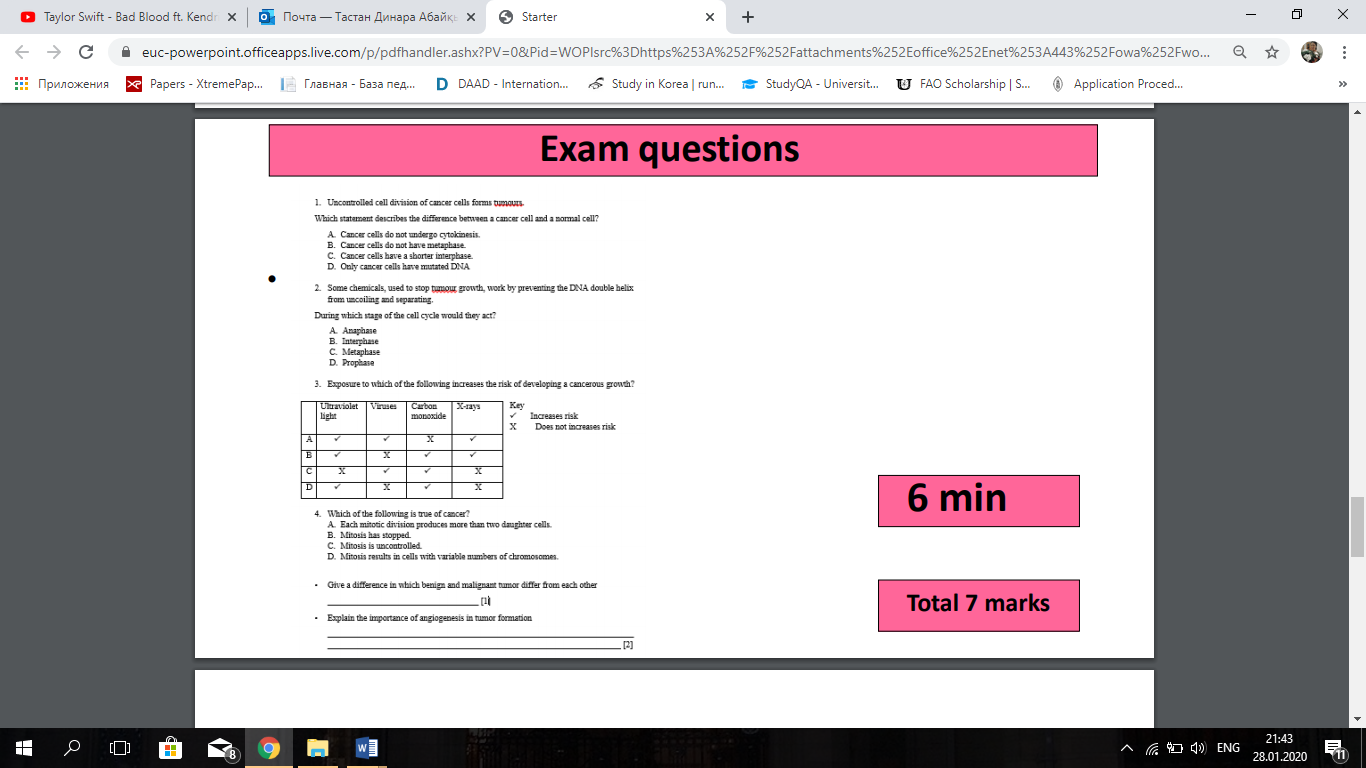|
|
11.3С Growth, development and
motion
|
School:
|
|
|
|
Date:
29.01.2020
|
Teacher name:
|
|
|
|
Grade:
11
|
Number of
present:
|
Absent:
|
|
|
|
Lesson
Theme:
|
Occurrence of
oncological neoplasms
|
|
|
|
Learning objectives
(ICBAM)
|
11.2.2.6 discuss factors causing
cancer;
|
|
|
|
Lesson objectives
|
-
Discuss the factors causing
cancer
-
Describe how uncontrolled cell division can lead
to the formation of tumours
-
Know differences between benign and
malignant tumours
|
|
|
|
Success
criteria
|
By the end of the lesson, students will be able
to:
-
Discuss the factors causing
cancer
-
Describe how uncontrolled cell division can lead
to the formation of tumours
-
• Know differences between benign and
malignant tumours
|
|
|
|
Language
objectives
|
|
Cancer
|
a group of diseases involving abnormal cell
growth with the potential to invade or spread to other parts of the
body.
|
|
|
|
Tumor
|
a mass of tissue that's formed by an
accumulation of abnormal cells.
|
|
Metastasis
|
a pathogenic agent's spread from an initial
or primary site to a different or secondary site within the host's
body
|
|
Cell cycle
checkpoints
|
are control mechanisms in
eukaryotic cells which ensure proper division of the
cell.
|
|
Benign
tumor
|
a mass of cells (tumor) that lacks the
ability to invade neighboring tissue (spread throughout the body)
or metastasize.
|
|
Malignancy
|
the tendency of a medical
condition to become progressively
worse.
|
|
Angiogenesis
|
the physiological process through which new
blood vessels form from pre-existing vessels, formed in the earlier
stage of vasculogenesis
|
|
Neoplasm
|
a type of abnormal and
excessive growth, called neoplasia, of
tissue.
|
|
|
|
|
Values instilled at the
lesson
|
This lesson is aimed
to develop the ability to work in groups, improve responsibilities
for tasks and leadership
skills.
|
|
|
|
Cross-curricular links
|
Chemistry, cell biology, developmental
biology
|
|
|
|
ICT
skills
|
During the study of
new material, students have the opportunity to work with the
equipment necessary for research, the preparation of presentations,
group work
|
|
|
|
Aim of professional
development
|
Improvement of
activity of students by group
work
|
|
|
|
Previous learning
|
Cancer, Cell cycle, Cell
division
|
|
|
|
Plan of the
lesson
|
|
|
|
|
Planned activities at the
lesson
|
Resources
|
|
|
|
1 min
2 min
4 min
10
min
8 min
3 min
6 min
2 min
2 min
2 min
|
Organization
moments. Greeting students, check
their preparation for the lesson (availability of school
supplies)
Activating prior
knowledge
Ts explain the topic and
lesson objectives
Terminology
Ss match terms with
definitions

Ts explains the Cancerogenesis
(factors causing cancer)

Project
work

Each group present their work
Ss
make an assessment to each other group
Exam
questions
LOTs and HOTs
questions

Self –
assessment
Reflection

Conclusion
|
PPT
PPT
https://www.youtube.com/watch?v=IeUANxFVXKc
Handout materials
A level biology questions /
save my exams
|
|
|
|
Differentiation – how do
you plan to give more support? How do you plan to challenge the
more able learners?
|
Assessment – how are you
planning to check students’ learning?
|
Health and safety
regulations
|
|
|
|
Differentiation can be by
task, by outcome, by individual support, by selection of teaching
materials and resources taking into account individual abilities of
learners (Theory of Multiple Intelligences by
Gardner).
Differentiation can be used
at any stage of the lesson keeping time management in
mind.
|
Use this section to record
the methods you will use to assess what students have learned
during the lesson.
|
Health promoting
techniques
Breaks and physical
activities used.
Points from Safety rules
used at this lesson.
|
|
















